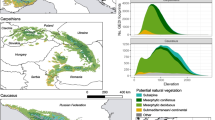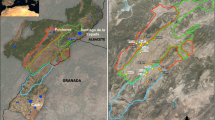Abstract
Long-term societal trends which include decreasing population in structurally poorer regions and changes in agricultural policies have been leading to land abandonment in various regions of Europe. One of the consequences of this development includes spontaneous forest regeneration of formerly open-land habitats with likely significant effects on plant and animal diversity. We assess potential effects of agricultural decline in Switzerland (41,000 km2) and potential impacts on the spatial distribution of seven open-land species (insects, reptile, birds) under land-use change scenarios: (1) a business-as-usual scenario that extrapolates trends observed during the last 15 years into the future, (2) a liberalisation scenario with limited regulation, and (3) a lowered agricultural production scenario fostering conservation. All scenarios were developed in collaboration with socio-economists. Results show that spontaneous reforestation is potentially minor in the lowlands since combinations of socio-economic (better accessibility), topographic (less steep slopes), and climatic factors (longer growing seasons) favour agricultural use and make land abandonment less likely. Land abandonment, spontaneous reforestation, and subsequent loss of open-land, however, are potentially pronounced in mountainous areas except where tourism is a major source of income. Here, socio-economic and natural conditions for cultivation are more difficult, leading to higher abandonment and thus reforestation likelihood. Evaluations for open-land species core habitats indicate pronounced spatial segregation of expected landscape change. Habitat losses (up to 59%) are observed throughout the country, particularly at high elevation sites in the Northern Alps. Habitat gains under the lowered agricultural production scenario range between 12 and 41% and are primarily observed for the Plateau and the Northern Alps.







Similar content being viewed by others
References
Araujo MB, Cabeza M, Thuiller W, Hannah L, Williams PH (2004) Would climate change drive species out of reserves? An assessment of existing reserve-selection methods. Glob Change Biol 10:1618–1626
Bakker J (1989) Nature management by grazing and cutting. Kluwer Academic Publishers, London
Bätzig W (1996) Landwirtschaft im Alpenraum unverzichtbar, aber zukunftslos? Eine alpenweite Bilanz der aktuellen Probleme und der möglichen Lösungen. In: Bätzig W (ed) Landwirtschaft im Alpenraum—unverzichtbar, aber zukunftslos? Europäische Akademie Bozen, Fachbereich Alpine Umwelt, Blackwell, Wien, pp 9–11
BFS (1979/85) Arealstatistik, Bundesamt für Statistik, Servicestelle GEOSTAT, CH-Neuchatel
BFS (1992/97) Arealstatistik, Bundesamt für Statistik, Servicestelle GEOSTAT, CH-Neuchatel
BLW (2003) Verordnungspaket 2007. Ausführungsbestimmungen zur Agrarpolitik 2007. Informationsveranstaltung vom 5.12.2003, Bundesamt für Landwirtschaft, Bern
BLW (2004) Agrarbericht 2004, Bundesamt für Landwirtschaft, Bern
Bolliger J, Kienast F, Zimmermann NE (2000) Risks of global warming on montane and subalpine forests in Switzerland. Region Environ Change 1:99–111
Brown DG (2003) Land use and forest cover on private parcels in the Upper Midwest USA, 1970 to 1990. Landscape Ecol 18:777–790
Copas J (1999) The effectiveness of risk scores: the logit rank plot. J Roy Stat Soc Ser C-Appl Stat 48:165–183
Deleo JM (1993) Receiver operating characteristic laboratory (ROCLAB): software for developing decision strategies that account for uncertainty. Proceedings of the first international symposium on uncertainty modelling and analysis. IEEE, Computer Society Press, College Park, MD, pp 318–325
Dirnböck T, Dullinger S, Grabherr G (2003) A regional impact assessment of climate and land-use change on alpine vegetation. J Biogeogr 30:401–417
Dullinger S, Dirnböck T, Grabherr G (2003a) Patterns of shrub invation into high mountain grasslands of the Northern calcareous Alps, Austria. Arct Antarct Alp Res 35:434–441
Dullinger S, Dirnböck T, Greimler S, Grabherr G (2003b) A resampling approach to evaluate effects of summer farming on subalpine plant species diversity. J Veg Sci 14:243–252
Edwards TC, Cutler R, Zimmermann NE, Geiser L, Alegria J (2005) Model-based stratification for enhancing the detection of rare ecological events. Ecology 86:1081–1090
Engler R, Guisan A, Rechsteiner L (2004) Predicting the distribution of rare and endangered species from occurrence and pseudo-absence data. J Appl Ecol 41:263–274
FAT (2002) Zentrale Auswertung von Buchhaltungsdaten, Tänikon
Fielding AH, Bell JF (1997) A review of methods for the assessment of prediction errors in conservation presence/absence models. Environ Conserv 24:38–49
Flury C (2002) Zukunftsfähige Landwirtschaft im Alpenraum, Diss. ETH Nr. 14528: Zürich
Gonseth Y (1987) Verbreitungsatlas der Tagfalter der Schweiz (Leptidoptera, Rhopalocera), 6. Documenta Faunistica Helvetica
Guisan A, Hofer U (2003) Predicting reptile distributions at the mesoscale: relation to climate and topography. J Biogeogr 30:1233–1243
Guisan A, Thuiller W (2005) Predicting species distributions: offering more than simple habitat models. Ecol Lett 8:993–1009
Guisan A, Zimmermann NE (2000) Predictive habitat distribution models in ecology. Ecol Model 135:147–186
Gustafson EJ (1998) Quantifying landscape spatial pattern: what is the state of the art? Ecosystems 1:143–156
Haines-Young R et al (2003) Changing landscapes, habitats and vegetation diversity across Great Britain. J Environ Manage 67:267–281
Hampe A (2004) Bioclimate envelope models: what they detect and what they hide. Global Ecol Biogeogr 13:469–476
Hannah L et al (2002) Conservation of biodiversity in a changing climate. Conserv Biol 16:264–268
Heller-Kellenberger I, Kienast F, Obrist M, Walter T (1997) Räumliche Modellierung der potentiellen faunistischen Biodiversität mit einem Expertensystem. Informationsblatt des Forschungsbereiches Landschaft 36
Heller-Kellenberger I, Kienast F, Obrist MK, Walther TA (2004) Biodiversity hostspots—modeling potential faunistic biodiversity with a spatially explicit expert system. Swiss Federal Research Institute WSL
Jenny M (1990) Populationsdynamik der Feldlerche Alauda arvensis in einer intensiv genutzten Agrarlandschaft. J Ornithol 131:241–265
Jepsen JU, Topping CJ, Odderskaer P, Andersen PN (2005) Evaluating consequences of land-use strategies on wildlife populations using multiple-species predictive scenarios. Agric Ecosyst Environ 105(4):581–594
Labaune C, Magnin F (2002) Pastoral management vs. land abandonment in Mediterranean uplands: impact on snail communities. Global Ecol Biogeogr Lett 11:237–245
Laiolo P, Dondero F, Ciliento E, Rolando A (2004) Consequences of pastoral abandonment for the structure and diversity of the alpine avifauna. J Appl Ecol 41:294–304
Li H, Wu J (2004) Use and misuse of landscape indices. Landscape Ecol 19:389–399
Lindbladh M (1999) The influence of former land-use on vegetation and biodiversity in the boreo-nemoral zone of Sweden. Ecography 22:485–498
Loehle C (2004) Challenges of ecological complexity. Ecol Complexity 1:3–6
Lundström-Gilliéron C, Schläpfer R (2003) Hare abundance as an indicator for urbanisation and intensification of agriculture in Western Europe. Ecol Model 168:283–301
Lütolf M, Kienast F, Guisan A (2006) Strategies to improve species distribution model performance using occurrence data. J Appl Ecol 43:802–815
Mack G, Ferjani A (2002) Auswirkungen der Agrarpolitik (2007) Modellrechnungen für den Agrarsektor mit Hilfe des Prognosesystems SILAS, FAT, Tänikon
Margalef R (1994) Dynamic aspects of diversity. J Veg Sci 5:451–456
McCracken DI, Bignal EM (1998) Applying the results of ecological studies to land-use policies and practices. J Appl Ecol 35:961–967
McGarigal K, Cushman SA, Neel MC, Ene E (2002) FRAGSTATS: Spatial pattern analysis program for categorial maps. Computer software program produced by the authors at the University of Massachusetts, Amherst, MA, USA. http://www.umass.edu/landeco/research/fragstats/fragstats.html
McKenzie D, Peterson DW, Peterson DL, Thornton PE (2003) Climatic and biophysical controls on conifer species distributions in mountain forests of Washington State, USA. J Biogeogr 30:1093–1108
Meeus J, Van Der Ploeg JD, Wijermans M (1991) Changing agricultural landscapes in Europe: continuity, deterioration or rupture? IFLA conference, Rotterdam, The Netherlands
Moreira F et al (2005) Effects of field management and landscape context on grassland wintering birds in Southern Portugal. Agricult Ecosyst Environ 109:59–74
Muller M, Spaar R, Schifferli L, Jenni L (2005) Effets of changes in farming of subalpine meadows on a grassland bird, the whinchat (Saxicola rubetra). J Ornithol 146(1):14–23
OECD (2002) Agricultural Policies in OECD countries. Monitoring and Evaluation, Paris
Orlowski G (2004) Abandoned cropland as a habitat for the Whinchat Saxicola rubetra in SW Poland. Acta Ornithologica 39:59–66
Sager J, Finger A (1992) Die Bodennutzung der Schweiz. Arealstatistik 1979/85. Kategorienkatalog. 002-8502, Bundesamt für Statistik, Bern. 191 pp
Schmid H, Luder R, Naef-Daenzer B, Graf R, Zbinden N (1998) Schweizer Brutvogelatlas. Verbreitung der Brutvögel in der Schweiz und im Fürstentum Liechtenstein 1993–1996. Schweizerische Vogelwarte, Sempach
Segurado P, Araujo MB (2004) An evaluation of methods for modelling species distributions. J Biogeogr 31:1555–1568
Söderström B, Svensson B, Vessby K, Glimskär A (2001) Plants, insects, and birds in semi-natural pastures in relation to local habitat and landscape factors. Biodivers Conserv 10:1839–1863
Soliva R, Rønningen K, Bella I, Bezak P, Cooper T, Flø BE, Marty P, Potter C. Envisioning Upland Futures: Stakeholder responses to scenarios for Europe’s mountain landscapes. J Rural Stud (accepted)
Statistisches Jahrbuch der Schweiz (1997) 104. Verlag Neue Zürcher Zeitung, Zürich
Thorens P, Nadig A (1997) Verbreitungsatlas der Orthopteren der Schweiz
Thuiller W, Araujo MB, Lavorel S (2003) Generalized models vs. classification tree analysis: predicting spatial distributions of plant species at different scales. J Veg Sci 14:669–680
Thuiller W, Araujo MB, Lavorel S (2004) Do we need land-cover data to model species distributions in Europe? J Biogeogr 31:353–361
Tilman D et al (2001) Forecasting agriculturally driven global environmental change. Science 292:281–284
Travis JMJ (2002) Climate change and habitat destruction: a deadly anthropogenic cocktail. Proc R Soc Lond B 270:467–473
Tucker GM, Heath MF (1994) Birds in Europe: their conservation status. Series No. 3. BirdLife International, Cambridge
van der Vaart JHP (2005) Towards a new rural landscape: consequences of non-agricultural re-use of redundant farm buildings in Friesland. Landscape Urban Plan 70:143–152
Verbyla DL, Litvaitis JA (1989) Resampling methods for evaluation classification accuracy of wildlife habitat models. Environ Manage 13:783–787
Weibel U (2004) Bauern, die Biodiversität produzieren. Ornis 2:4–8
Wu J (1999) Hierarchy and scaling: extrapolating information along a scaling ladder. Int J Remote Sensing 25:367–380
Wu J (2004) Effects of changing scale on landscape pattern analysis: scaling relations. Landscape Ecol 19:125–138
Wu J (2006) Landscape ecology, cross-disciplinarity, and sustainability science. Landscape Ecol 21:1–4
Wu J, Hobbs R (2002) Key issues and research priorities in landscape ecology: an idiosyncratic synthesis. Landscape Ecol 17:355–365
Wu J, Shen W, Sun W, Tueller PT (2002) Empirical patterns of the effects of changing scale on landscape metrics. Landscape Ecol 17:761–782
Zaniewski AE, Lehmann A, Overton JM (2002) Predicting species spatial distributions using presence-only data: a case study of native New Zealand ferns. Ecol Model 157:261–280
Zimmermann NE (2001) SimTest. http://www.wsl.ch/staff/niklaus.zimmermann/programs/fort10_1.html, WSL, Birmensdorf
Zimmermann NE, Kienast F (1999) Predictive mapping of Alpine grasslands in Switzerland: species versus community approach. J Veg Sci 10:469–482
Acknowledgements
Many thanks to the Centre Suisse de Cartographie de la Faune, Neuchâtel (Simon Capt, Yves Gonseth) for their expert advice and for providing the species data. We would also like to thank Thomas Niemz for kindly conducting some of the GIS analyses. This research was supported by the BioScene project funded by the European Union (EVK2-2001-00354).
Author information
Authors and Affiliations
Corresponding author
Rights and permissions
About this article
Cite this article
Bolliger, J., Kienast, F., Soliva, R. et al. Spatial sensitivity of species habitat patterns to scenarios of land use change (Switzerland). Landscape Ecol 22, 773–789 (2007). https://doi.org/10.1007/s10980-007-9077-7
Received:
Accepted:
Published:
Issue Date:
DOI: https://doi.org/10.1007/s10980-007-9077-7




